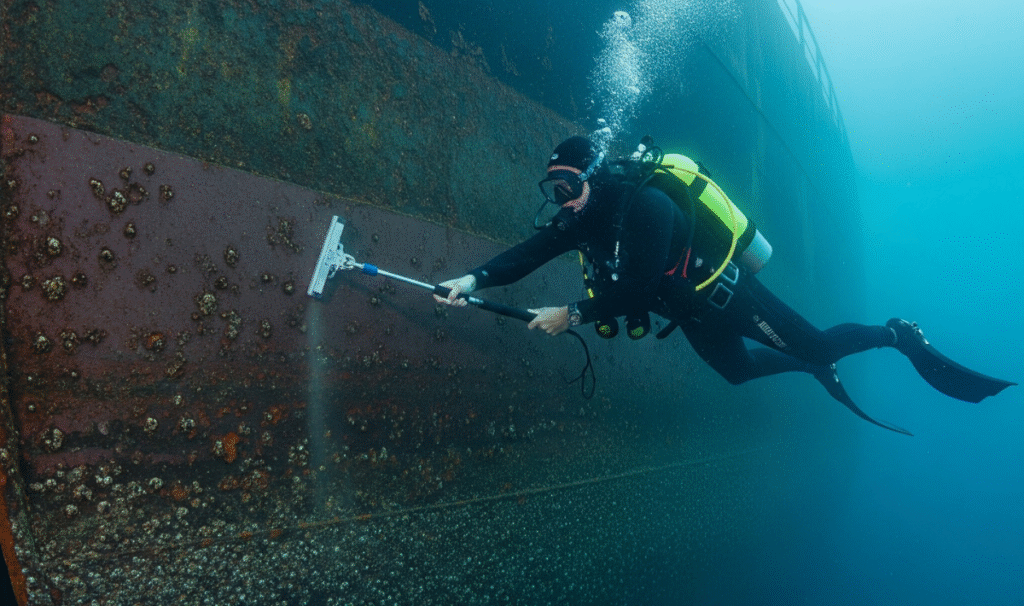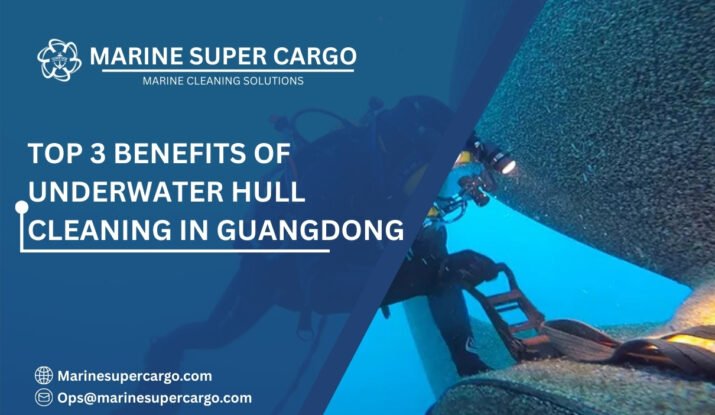When you see a ship cruising through the Pearl River Delta or docking at Guangzhou’s ports, you notice its towering cranes, bustling cargo, and powerful engines. What you don’t always notice is the vast hidden surface underwater—the hull. That’s where the real battle for efficiency and safety rages.
The ocean is alive with barnacles, seaweed, algae, and all kinds of marine organisms. They cling to steel like determined hitchhikers. Over time, this creates drag, increases fuel burn, and even invites corrosion. For vessels passing through Southern China’s warm currents, underwater hull cleaning in Guangdong is no longer optional—it’s essential if you want faster voyages, reduced costs, and greener operations.
Let’s unpack the underwater hull cleaning in Guangdong that makes it a smart investment for today’s shipping industry.
What is Underwater Ship Hull Cleaning?
The Basics of Hull Cleaning
Hull cleaning is like giving a ship a refreshing underwater spa treatment. Trained divers or robotic machines brush off slime, scrape barnacles, and wash away biofouling from the submerged surfaces. The aim? Restore the sleek, hydrodynamic profile of the hull, which nature continuously tries to roughen up.
Ships that undergo underwater hull cleaning in Guangdong reclaim their fluid motion, glide through the water with less resistance, and consume much less fuel.
Why Guangdong is a Strategic Location for Hull Cleaning
Guangdong is China’s maritime powerhouse—home to world-class ports like Guangzhou and Shenzhen. Ships dominate trade routes here, moving goods across Asia and far beyond. But the warm, nutrient-rich waters in the region also encourage rapid biofouling. That makes underwater hull cleaning in Guangdong not just beneficial but critical for ships operating in these seas.

Increased Fuel Efficiency and Smarter Performance
How Biofouling Affects Fuel Use
A fouled hull is the marine equivalent of dragging a parachute while running. Even a thin layer of slime can crank up fuel costs significantly. Research from imo.org shows that light biofouling increases fuel use by up to 10%, while heavy barnacle infestation can push that number up to 40%.
The Noticeable Change After Cleaning
Here’s where underwater hull cleaning in Guangdong pays dividends. Immediately after cleaning, captains report faster speeds, better response from steering systems, and reduced engine strain. The ship suddenly feels lighter, more agile—like it’s cutting through butter instead of pushing against syrup.
Protecting the Environment and Meeting Compliance Standards
Reducing Biofouling and Invasive Species
Hull fouling isn’t just a financial drain—it’s an ecological hazard. When organisms hitchhike from one port to another, they can collapse local ecosystems. Regular underwater hull cleaning in Guangdong safeguards biodiversity by minimizing the spread of invasive species.
The MARPOL Convention emphasizes pollution reduction and eco-friendly vessel operations. Hull maintenance is a central part of this movement.
Staying Compliant with MARPOL and IMO Guidelines
Ship operators risk port restrictions, penalties, and reputational harm if they fail to maintain hull standards. Organizations like iaphworldports.org reinforce this point, stressing how clean hulls are pivotal for sustainable shipping. By prioritizing underwater hull cleaning in Guangdong, vessels comply with international guidelines while protecting marine ecosystems.
Long-Term Cost Savings and Vessel Longevity
Slowing Down Corrosion and Damage
Marine growth doesn’t just hitch a ride. It actively degrades hull surfaces, trapping moisture, eroding paint, and corroding steel. Left unchecked, the damage snowballs into major repair bills. Regular underwater hull cleaning in Guangdong keeps coatings intact and protects valuable steel structures from early wear.
Reducing the Need for Expensive Repairs
Every session of cleaning saves thousands of dollars down the line. Prevention is healthier than cure—both for humans and for ships. Instead of facing surprise dry-docking or emergency repairs, owners who invest in hull cleaning enjoy smoother maintenance cycles and predictable costs.
Hull Cleaning in the Bigger Picture of Maritime Shipping
Role in Green Shipping and Carbon Reduction
Shipping is under growing pressure to decarbonize. Every extra ton of fuel burned equals more greenhouse gases in the atmosphere. Regular underwater hull cleaning in Guangdong feeds directly into this mission: reducing drag lowers fuel consumption, which in turn cuts carbon emissions. According to cleanship.co, hull cleaning is one of the quickest and most cost-effective ways to slash emissions.
Guangdong as a Leader in Sustainable Port Operations
With its massive trade volume and advanced infrastructure, Guangdong is at the forefront of green shipping practices. Ports here encourage eco-compliant cleaning, contributing to global initiatives led by the IMO. This makes underwater hull cleaning in Guangdong not just a maintenance service but an integral part of sustainable maritime logistics.
Best Practices for Underwater Hull Cleaning in Guangdong
Importance of Certified Divers and Equipment
Hull cleaning isn’t a casual scrub job—it involves specialized tools and skilled technicians trained to meet international guidelines. Many providers in Guangdong follow standards laid out by imca-int.com. Certification ensures hulls are cleaned thoroughly and safely without harming coatings or marine life.
Combining Hull Cleaning with Inspections
Smart operators double up—using hull cleaning sessions as opportunities for inspections. Propellers, thrusters, and rudders are also examined during underwater hull cleaning in Guangdong, making it a preventive maintenance win-win.

Challenges of Hull Cleaning in Guangdong’s Waters
Seasonal Growth and Water Conditions
Southern China’s climate encourages faster biofouling in certain seasons. Summer, with its warmer waters, often accelerates marine growth. Ships plying Guangdong’s ports should schedule underwater hull cleaning in Guangdong accordingly to maintain performance.
Balancing Speed with Environmental Care
Rushed or aggressive cleaning can harm hull coatings or release debris into the sea. The best approach strikes a balance—eco-friendly methods that prioritize both efficiency and environmental responsibility. Thankfully, Guangdong has been adopting advanced eco-conscious practices to lead the charge in responsible cleaning.
Conclusion
Ships may be giants, but their greatest challenges often come from the smallest organisms. Barnacles, algae, and slime collectively cost billions in excess fuel, repairs, and environmental damage. That’s why the underwater hull cleaning in Guangdong—better efficiency, stronger compliance, and reduced costs—is so crucial.
Every voyage becomes smoother. Every inspection becomes easier. And every journey contributes to building a greener and smarter shipping industry.
For shipping companies, investing in underwater hull cleaning in Guangdong isn’t just maintenance—it’s a strategy. It’s a way of unlocking smoother operations, a competitive edge, and a sustainable future.
FAQ:
Q1. How often should ships schedule underwater hull cleaning in Guangdong?
Most vessels benefit from cleaning every 6–12 months, but ships in Guangdong’s warm, fouling-prone waters may need more frequent sessions.
Q2. Is hull cleaning environmentally safe in Guangdong?
Yes—eco-friendly methods and international compliance standards guide most providers to ensure minimal environmental impact.
Q3. Can underwater hull cleaning reduce carbon emissions?
Absolutely. By reducing drag and fuel burn, ships undergoing underwater hull cleaning in Guangdong cut their emissions significantly.
Q4. Does cleaning extend the vessel’s lifespan?
Yes, since it prevents corrosion and preserves coating, which delays major repairs.
Q5. Why is Guangdong considered a prime hub for hull cleaning?
Because of its high maritime traffic, warm waters that demand frequent cleaning, and its leadership in sustainable port operations.


